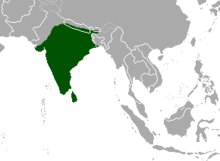Mouflon
From Wikipedia, the free encyclopedia
(Redirected from Mouflon sheep)
| Mouflon | |
|---|---|
 | |
| Mouflon in the Buffalo Zoo | |
| Conservation status | |
| Scientific classification | |
| Kingdom: | Animalia |
| Phylum: | Chordata |
| Class: | Mammalia |
| Order: | Artiodactyla |
| Family: | Bovidae |
| Subfamily: | Caprinae |
| Genus: | Ovis |
| Species: | Ovis aries |
| Binomial name | |
| Ovis aries Linnaeus, 1758 | |
| Synonyms | |
O. orientalis Ovis musimon Ovis gmelini | |
The mouflon (Ovis aries orientalis[1] group) is a subspecies group of the wild sheep Ovis aries. Populations of Ovis aries can be partitioned into the mouflons (orientalis group) andurials or arkars (vignei group).[2] The mouflon is thought to be one of the two ancestors for all modern domestic sheep breeds.[3][4]
Contents[hide] |
[edit]Description
Mouflon have a red-brown short-haired coat with a dark back-stripe, light colored saddle patch . The males are horned; some females are horned while others lack horns. The horn is curved in almost one full revolution (up to 85 cm). Mouflon have a shoulder height of about 0.9 meters and a body weight of 50 kg (males) and 35 kg (females).[5]
[edit]Range
Today mouflon inhabit the Caucasus, northern Iraq, and northwestern Iran. Originally the range stretched further to Anatolia, the Crimeanpeninsula and the Balkans, where they had already disappeared 3,000 years ago. Mouflon were introduced to the islands of Corsica, Sardinia,Rhodes and Cyprus during the neolithic period, perhaps as feral domesticated animals, where they have naturalized in the mountainous interiors of these islands over the past few thousand years, giving rise to the subspecies known as European mouflon (O. aries musimon). In the island of Cyprus the moulfon or Agrino became a different and endemic species, which only found in Cyprus, the Cyprus moulfon (Ovis orientalis ophion). The Cyprus moulfon is about 3000 animals, only. They are now rare on the islands but classified as feral animals by the IUCN.[6] They were later successfully introduced into continental Europe, including Spain, France, Germany, central Italy, Switzerland, Austria, the Netherlands, the Czech Republic, Poland, Slovakia, Hungary, Bulgaria, Romania, the Canary Islands, and even some northern European countries such asSweden and Finland. A small colony exists in the remote Kerguelen Islands in the southern Indian Ocean, and on the Veliki Brijun Island in the Brijuni Archipelago of the Istrian Peninsula in Croatia. In South America mouflon have been introduced into central Chile and Argentina[7]. Since the 1980s, mouflon have also been successfully introduced into game ranches in North America for the purpose of hunting; however in game ranches pure breeds are rare as mouflon interbreed with domestic sheep and bighorn sheep.[citation needed] Mouflon have also been introduced into Hawaii as game animals, where they cause serious damage to native plant species and are more difficult to control than other alien ungulates.
Their habitat is steep mountainous woods near the tree line. In Winter they migrate to lower altitudes.[5]
[edit]Subspecies
The scientific classification of the mouflon is disputed.[8] Five subspecies of mouflon are distinguished by MSW3:[2]
- Armenian mouflon (Ovis orientalis gmelini (Blyth, 1851)). It has been introduced in Texas state of USA.
- European mouflon (Ovis orientalis musimon (Pallas, 1811)). About 7,000 years ago the European mouflon appeared in Corsica and Sardinia for the first time. It has been introduced in many parts of Europe.
- Cypriot mouflon (Ovis orientalis ophion Blyth, 1841) (also called Agrino, from Greek Αγρινό). Cypriot mouflon was nearly extirpated during the 20th century. In 1997 about 1,200 of this subspecies were counted.
- Iranian Red sheep (Ovis orientalis orientalis Gmelin, 1774). Caucasus, northwestern Iran and southern Anatolia. Scientific nomenclature unclear; sometimes also called gmelini.
- Esfahan mouflon (Ovis orientalis isphahanica Nasonov, 1910). Zagros Mountains, Iran.
- Laristan mouflon (Ovis orientalis laristanica Nasonov, 1909). A small subspecies, with range is restricted to some desert reserves nearLar in southern Iran.
A mouflon was cloned successfully in early 2001 and lived at least seven months, making it the first clone of an endangered mammal to survive beyond infancy.[9][10][11] This demonstrates that a common species (in this case, a domestic sheep) can successfully provide a surrogate for the birth of an exotic animal like the mouflon. If cloning of the mouflon can proceed successfully, it has the potential to expand the species' gene pool and reduce strain on the number of living specimens.
[edit]Mouflon in culture
- The mouflon is featured on the symbol of Cyprus Airways, as well as on the 1, 2, and 5 cent Cypriot euro coins.
- The mouflon is featured on the historic flag of Armenian kingdom Syunik, as well as on the tombstones.
- The similarity of the mouflon to domestic sheep, combined with its threatened status, has made it a subject of interest, both scientific and popular, in the use of biotechnology in species preservation.[12]
- Ref http://en.wikipedia.org/wiki/Mouflon_sheep












